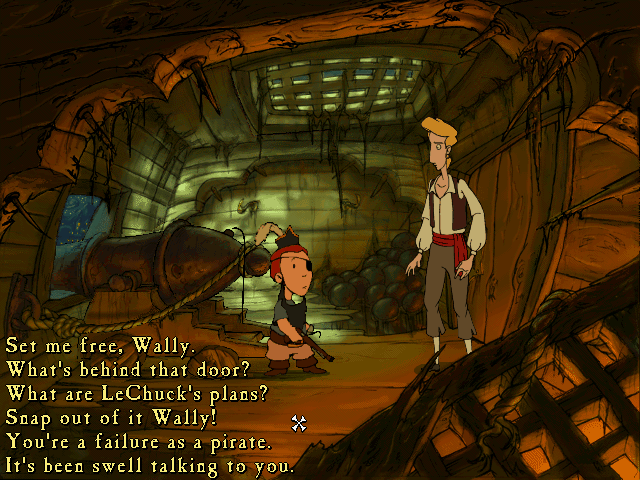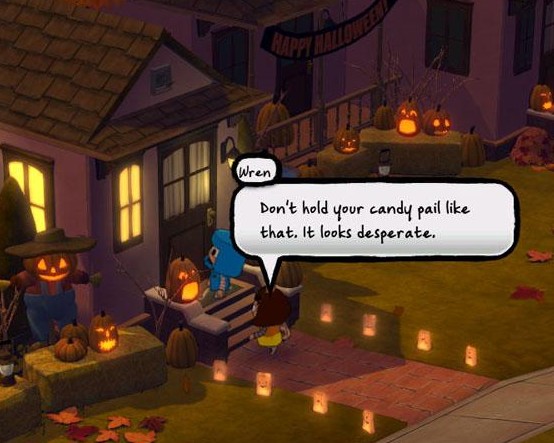I’ve been playing Stacking, the new game from Tim Schafer and Double Fine. If you are unfamiliar with the superstars of geekdom who dot my personal firmament, Schafer was a designer on almost all the best adventure games: the first two Monkey Island games, The Day of the Tentacle, Psychonauts, and the very best game ever made, Grim Fandango. He helped invent things like, say, the dialogue tree,* where your character has multiple response options which sometimes dictate the direction of conversations. (In games before that, all you could do was click on a character and watch a pre-scripted conversation. So much more fun to have the option to ask different questions or hurl insults. You’re a failure as a pirate, Wally!)
This is actually from Monkey Island 3. Not a Schafer game, but the dialogue tree tradition was by now well-established.
I had already played Costume Quest, Schafer’s follow-up to his massively awesome Psychonauts, and had found it sort of…limited? Fun and cute, filled with Schafer’s trademark amusing dialogue, but kind of repetitive.
Screenshot from Costume Quest: “Don’t hold your candy pail like that. It looks desperate.” Pretty good, although the best line is from one of the villains just before he attacks you: “You remind me of my parents…from whom I am bitterly estranged!”
Still, I was excited about Stacking because the premise looked so out-of-control awesome: you play a tiny Russian doll named Charlie who moves through a world filled with other stacking Russian dolls. To solve puzzles, you “stack” into dolls of larger and larger sizes, each of whom has a special ability which may help you solve challenges or side quests. Also, the graphics and soundtrack looked really beautiful.
Now I’ve played a few hours of the game. And the graphics and soundtrack are really beautiful, and the concept is as neat as it sounded, but the game itself is just…boring and hard.
For one thing, Stacking is set in an Industrial Revolution-era world full of amusing child labor and robber-baron-types, which is pleasingly dark in tone, but unfortunately also dark in color. I keep finding myself in rooms where the mood lighting is so dim that it’s almost impossible to see what’s going on. Also, the game was originally created for Playstation, so the PC controls are kind of difficult to use. (I don’t know if I can really blame Double Fine for my unwillingness to buy a Playstation, but I am happy to try.) And I sort of hate first-person games anyway. I get a little nauseated if I play them for too long. (This was a problem I had with Psychonauts, too.) I miss side-scrolling adventures, you know? Just show me everything in the room on one screen, don’t make me waggle the character’s head around.
And then there are the puzzles themselves. Rather than putting in a lot of different kinds of fiendishly difficult item-based puzzles, a la classic adventure gaming, Schafer & co. have created fewer puzzles that each have three different solutions. And each solution requires figuring out which doll to use and then wandering around an enormous space full of dolls until you find the one you need; also, that’s the whole solution, because once you’re in the doll, you have the necessary power to solve the puzzle. This gets very, very boring. I think Double Fine knew it would, too, because when you try to leave a world before you’ve found all the solutions to each puzzle, you get a little pop-up message saying something like “Are you sure? A true adventurer wouldn’t leave so much undone!” It reeks of desperation, like a time-share salesman thrusting pamphlet after pamphlet at you as you head for the door.
Mind you, I am not blaming Double Fine. There’s a dearth of adventure games on the market these days, which leads me to believe there’s a dearth of old school players like me who just want to combine items into other items to solve puzzles. This impression is borne up by the reviews of Stacking which seem to be universally positive, as though reviewers are so grateful to be reviewing something that doesn’t involve shooting a disturbingly realistic humanoid figure that they will settle for anything. So yes, I do realize that I can’t expect a company to make games that no one but me wants to play. (Although the new Monkey Island game by Telltale is just wonderful in every way; to say nothing of their Sam & Max series. And Amanita Design’s Machinarium, which was made just a few years ago, is one of the best and prettiest adventure games I’ve ever played. So obviously some designers love me.)
Anyway, what do I know? I am getting more old-ladyish by the day. Games were better in my youth, and kids were more respectful, and Robin McKinley wrote readable books and Chris Cornell wrote good songs. And ozone! Call this an ozone layer, I don’t. Not a patch on the layer we used to have, let me tell you. So go ahead and play Stacking, youth of America. I’ll just be over in this corner with Manny Calavera, grumbling about better days.
R.I.P. awesome adventure games. Except Machinarium. And stuff from Telltale.
*It’s worth noting that my info on this comes from an in-game commentary by Schafer himself, where he and the other Monkey Island designers mention that they were the first ones to create a dialogue tree. So…grain of salt, I guess?




